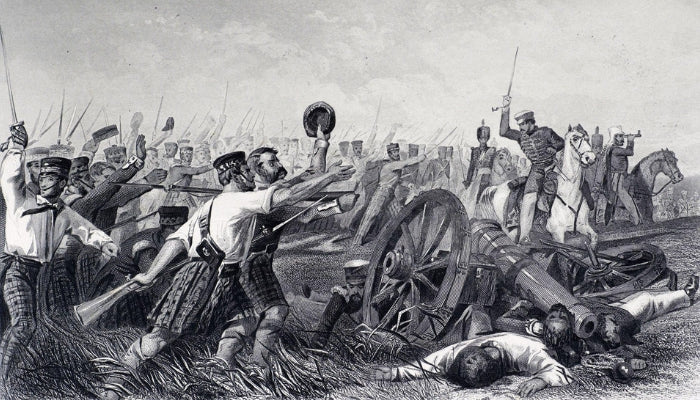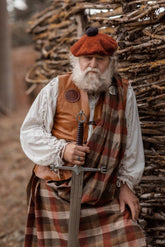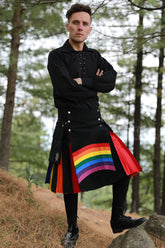Famous Tartans of Ireland: A Deep Dive into History!
History of Irish Tartans:
Tartan, a distinctive fabric characterized by intersecting, vibrant bands, is commonly linked to Scottish cultural heritage, yet it also possesses a historical presence in Ireland. The incorporation of tartan into Irish culture is a relatively contemporary phenomenon, dating back to the 1990s. The initial Irish tartans were specifically crafted for the 32 traditional Irish counties, with recent iterations drawing inspiration from well-known Irish family names. Among the notable Irish tartans, the Ulster Tartan holds particular prominence, having been discovered in the 1950s and traced back to the early 1600s. This tartan's origins lie in remnants of clothing unearthed on a farm near Derry, specifically in Dungiven, featuring fragments of tartan trews. The Ulster region's historical ties to Scottish emigrants contribute to the Scottish influence evident in this discovery. Despite the debates and enigmas surrounding Irish tartans, they have evolved into a significant facet of Irish cultural expression, serving as a compelling means of showcasing and preserving Irish heritage.

What is an Irish Tartan made of?
An Irish tartan is a vibrant patterned cloth crafted from acrylic wool, featuring criss-crossed, horizontal, and vertical bands in various colors, creating intricate rectangular designs. Unlike Scotland, where tartans symbolize clans, Irish tartans uniquely represent counties or districts of Ireland. Many individuals from Ireland choose to proudly wear the tartan associated with their family's origins. For instance, if your roots trace back to Cork, you might don the distinguished Cork County Tartan. Explore the exquisite collection of Irish mens kilt, including authentic county tartans, to embrace and showcase your Gaelic heritage. The introduction of the Irish national tartan, steeped in the rich history of Irish nationalism, serves as a powerful symbol of enduring Gaelic tradition.
Famous Tartans of Ireland:
Irish County Tartans, introduced in 1996 by the House of Edgar, represent various Irish counties, allowing wearers to celebrate their Irish roots by honoring their family's ancestral home. These tartans have gained global popularity and emerged as a symbol of Gaelic practice amid anglicization in Ireland. Unlike Scotland, Ireland has fewer tartan colors, leaning towards green and ochre, with notable ones like St. Patrick, Peter Callaghan, and Tara Murphy. The Saffron Kilt, a mustard yellow kilt with shamrock appliques, is a distinctive Irish design. The Ulster Red and Ulster Saffron tartans are considered top choices. The use of tartan in Ireland is a relatively recent phenomenon, with the first Irish tartans designed for the 32 old Irish counties. The Irish National Tartan was introduced as a symbol of Gaelic tradition during the rise of Irish patriotism. Here are some famous tartans of ireland:
County Antrim Tartan
County Antrim, located in Northern Ireland, has a rich clan history. It is known for its spectacular coastal scenery and is home to the famous Giant's Causeway. The county has a history of Viking invasions and Gaelic power, and its tartan is associated with various clans, including Aiken, Bell, Boyd, Campbell, Craig, and many others. County Antrim was inhabited by a Celtic people called the Darini in ancient times and was part of the Kingdom of Ulidia in the early Middle Ages. The county has a long history of interaction with Scotland, and in more recent times, it became the home of a number of Ulster Scots Planters. During the Tudor era in the 16th century, many Scots settled in Antrim. The area also played a role in the Spanish Armada's history, with one of the 24 wrecks occurring on the Antrim coast in 1588. If you are interested in delving into your family history in County Antrim, you can find a wealth of genealogical records, including birth records, marriage records, death records, census records, parish registers, and military records.
The County Antrim tartan is primarily green with navy blue, gold, and orange stripes. The colors in the tartan represent specific elements of the county's landscape and history, creating a meaningful connection for those wearing it. Blue and green represent the sea and countryside, yellow represents the sun, while black and red stripes symbolize the strength and determination of Antrim's people. This tartan is often worn by people with a connection to the county, such as those who were born there or who have family ties to the region.

County Armagh Tartan
County Armagh has a rich clan history, with prominent Irish clans such as the descendants of the Collas, the O'Hanlons and Mac Cana, and the Uí Néill, the O'Neills of Fews. The tartan is mainly associated with the MacNeice clan, which was a prominent family in County Armagh, Northern Ireland. The MacNeice clan was known for their military prowess and played a significant role in the Battle of the Boyne in 1690. The county was divided into several baronies, each held by different clans, such as the O'Rogans, O'Neills of the Fews, O'Larkins, and O'Garveys. Armagh was strategically important during the 16th century Tudor conquest of Ireland, leading to conflicts between the English and the O'Neills. The area was also the seat of St. Patrick and continues to be a significant location for the Catholic Church.
The County Armagh Tartan, crafted from Acrylic wool fabric, features a distinctive design. The vibrant hues of green, butter yellow, and red accents reflect the county's landscape and cultural vibrancy. Green signifies the lush fields, yellow embodies the golden harvests, and red symbolizes the resilience and passion of its people. This combination creates a visually captivating tartan that not only honors the historical significance of County Armagh but also serves as a testament to the enduring spirit of its residents. Each color tells a story, weaving together the tapestry of this tartan that stands as a proud emblem of this county's heritage.
County Carlow Tartan
This tartan represents County Carlow, which is part of the Leinster Province in Ireland. Clans originating or associated with County Carlow include Brennan, Butler, Byrne, Carew, Cheevers, Cooke, Doyle, Eustace, Fitzgerald, Fortune, Kavanagh, Kelly, Kinsella, Leighlan, Lombard, MacMurrough, McDonald, Mullins, Murphy, Neill, Nolan, O'Bolger, O'Cahill, O'Cavanaugh, O'Doyle, O'Esmond, O'Flynn, O'Gahan, O'Gorman, O'Kelly, O'Kinsellagh, O'Murphy, O'Nolan, O'Ryan, O'Shea, O'Toole, Ryan, Strongbow, Tallon, Wall, and Whelan. The county's history dates back to the Neolithic period and has been marked by battles, invasions, and rebellions. The Anglo-Norman age left its mark on Carlow town in the shape of Carlow Castle, built between 1207 and 1213 AD by William the Marshal, Earl of Pembroke and Lord of Leinster. The county's history is also intertwined with the 1798 Rebellion, which saw Carlow at war and resulted in the massacre of 600 people. Carlow's history is well-preserved and is a source of pride for its residents.
The County Carlow Tartan is a visual tapestry of tradition, featuring a blend of black with green and purple hues. This distinctive pattern is characterized by crisscrossing lines of different widths, creating a unique and eye-catching design. The use of black, green, and purple in the tartan is symbolic of the county's natural landscape, with green representing the lush countryside, black symbolizing the rich soil, and purple signifying the heather that blooms across the region.
County Cavan Tartan
The County Cavan Tartan holds profound ties to esteemed clans such as Brady, Clarke, Curry, and others. Embodying the county's ethos, the motto "Feardhacht is Fírinne," translating to "Manliness and Truth," adds significant meaning to this tartan, symbolizing the pride and values of County Cavan. Nestled in the northeastern province of Ulster, Ireland, the county boasts a diverse history dating back to prehistoric times. Initially a Gaelic lordship under the O'Reillys' control, known as 'east Breifne,' it was established in 1579. The region's settlement dates back to prehistoric times, evidenced by grave complexes in the Burren, Blacklion, and Cohaw. The Ulster Plantation scheme in 1610 brought transformative changes, impacting population and urbanity. The 1641 rising brought violence and upheaval, documented through depositions, shedding light on County Cavan's social and cultural landscape. Historically part of the kingdom of Bréifne in the early 17th century, Cavan became a designated part of Ulster and joined the Ulster Plantation from 1608 onward.
Designed by Polly Kitteridge in 1997 for the House of Edgar, the County Cavan Tartan intricately captures the essence of the region. This conventional plaid features a harmonious blend of green, red, and brown, complemented by dark and tan accents. Green, symbolizing the lush landscapes, intertwines with red, reminiscent of historical struggles. Brown, paired with dark and tan accents, pays homage to the terrain features—sharp hills and loughs—serving as natural defenses throughout history.

County Clare Tartan
The County Clare Tartan, representing Clare County in the Munster Province of Ireland, boasts a rich history dating back to the era of the Meic Fhlannchadha, a prominent Brehon family in Gaelic tradition. As esteemed Brehon lawyers, they held a privileged status in Gaelic society. County Clare tartan’s motto, "Dílis d'ár nOidreacht," translates to "True to our heritage" in Irish. Associated clans like Boland, Brady, Bryant, Burke, and Clancy contribute to Clare's vibrant clan history. Notably, the O'Brien family, particularly the Earls of Clare, played a pivotal role in the county's traditional pursuits. Clare's name, Clár, meaning "a bridge of planks," reflects its connection to the Kingdom of Thomond in the old Gaelic system. With prehistoric and early Christian sites, Clare encapsulates a diverse and extensive history.
The traditional plaid features a harmonious blend of red, green, and navy blue, resonating with County Clare's cultural identity. Vibrant gold accents add a touch of elegance, reflecting the region's resilience and optimism. Each hue carries significance, mirroring the landscape and heritage. The tartan becomes a living tapestry, visually narrating the story of County Clare's past, present, and the enduring ties that bind its people across continents.
County Cork Tartan
The County Cork Tartan stands as a distinctive emblem, symbolizing the rich history and heritage of County Cork within Ireland's Munster Province. This unique tartan fosters a profound sense of pride and connection among its residents, encapsulating the cultural tapestry of the region. Linked to esteemed clans such as Ahern, Barrett, Barry, Fitzgerald, Murphy, and O'Brien, the County Cork Tartan embodies a shared identity. Historically, County Cork has witnessed the dominance of the Hiberno-Norman FitzGerald dynasty, later facing upheaval during the Desmond Rebellions. Noteworthy clans like the O'Callaghans contribute to the county's diverse history, offering a meticulously researched and eloquently presented legacy. Exploring one's ancestry in County Cork is facilitated by an array of genealogy records and collections.
The County Cork Tartan showcases a delightful blend of colors that represent the diverse landscape of County Cork, Ireland. The dominant shades of green and red mirror the lush fields and earthy terrain, while navy blue hints at the deep, mysterious lochs that dot the landscape. The bursts of bright yellow are like beams of sunlight piercing through the Scottish mist, bringing a sense of warmth and energy to the design.
County Donegal Tartan
The County Donegal Tartan is a symbol of the rich history and spirit of County Donegal, Ireland. This tartan is associated with the various clans of the county, including O'Donnell, MacSweeney, and O'Boyle, among others. The O'Donnell dynasty, one of the most powerful native families in Ireland, ruled the Gaelic kingdom of Tir Chonaill in West Ulster, which covered all of modern-day County Donegal. It is also known as County Tyrconnell, from the ancient kingdom that covered much of the west of Ireland. Family history research is available at the Donegal County Library, which aims to establish genealogical facts such as names, places of residence, and dates of birth, marriage, and death. Its history is a fascinating and tumultuous one, with connections to ancient origins and significant historical events.
The County Donegal Tartan is a traditional plaid pattern featuring a vibrant palette with green, blue, orange, and red. Designed by Polly Kitteridge for the House of Edgar in 1997. The colors of the tartan are said to represent the natural landscape and history of the county, with the blue and green symbolizing the sea and countryside, and the yellow representing the sun.

County Down Tartan
County Down Tartan proudly embraces the motto "Absque Labore Nihil," translating to "nothing without labor," symbolizing its industrious origins. Rooted in Northern Ireland's County Down, allocated to Great Britain in 1920, this tartan encapsulates the region's historical significance. With nods to the majestic Mourne Mountains, immortalized in Percy French's tune, it weaves a narrative of labor and legacy, embodying the enduring spirit of its people. Representing the Ulster Province, the tartan is linked to diverse clans such as Andley, Arthur, Bell, Black, and more. This tartan unfolds a rich tapestry of history, deeply connected to Northern Ireland's landscapes, marked by Gaelic, English, and Scottish influences, and shaped by settlements like the Ulster Plantation in the 17th century. Notable families, including the Hills and Wards, contribute to the county's storied past.
The tartan is predominantly white, with blue, orange, brown, and gray stripes woven throughout. The blue stripes represent the sea, while the orange and brown stripes represent the earth and the landscape of County Down. The gray stripes represent the granite that is found in the area. This tartan is a beautiful representation of the natural beauty of County Down, and its colors and patterns are a testament to the rich history and culture of Scotland.
County Dublin Tartan
County Dublin, Ireland, boasts a distinctive tartan intertwined with the rich heritage of numerous clans such as Bagott, Brady, Buckley, and more. This unique pattern reflects the county's cultural diversity and historical significance. Nestled around the capital city of Dublin, the region has a storied past dating back to the eighth century when Vikings established a settlement. The Battle of Clontarf in 1014 marked the Irish reclaiming part of the area, while 1169 saw Dublin becoming the epicenter of Norman activities in Ireland. Over time, English influence expanded, with Dublin's population reaching 60,000 by 1644. Presently divided into four local government authorities, namely Dublin City, Dun Laoghaire–Rathdown, Fingal, and South Dublin, this county remains a testament to Ireland's enduring history and cultural tapestry.
The County Dublin Tartan features a distinctive color palette that reflects the essence of the region. Its vibrant pattern consists of lines in Green, Brown, Red, and Black, representing the county's natural landscapes and rich history. The Green symbolizes the lush countryside, while the Brown and Black represent the earth and the cityscape, respectively. The Red is often associated with the county's historical significance and is a nod to its heritage and culture.
County Fermanagh Tartan
The County Fermanagh Tartan has a rich history rooted in Scottish tradition. Tartan, a fabric with complex patterns and vibrant colors, was originally reserved for the upper levels of Highland society. Over time, it has transcended gender, location, age, class, and climate, becoming a symbol of national pride. This tartan has also made its mark in the world of fashion, with designers like Vivienne Westwood using it in their collections. County Fermanagh has a rich clan history, with the Maguire clan being a prominent force in the area. The Maguires were the chiefs of the Maguire dynasty, and Fermanagh was often referred to as "MacGuire's country" due to their power. The county's history is also intertwined with the O'Donnells, O'Neills, and Normans. The area's abundant water facilitated early settlement, and it has a strong tradition of early Christian and Celtic influence. Its clan history is a complex tapestry of battles, alliances, and power struggles, making it a fascinating area for those interested in Irish history.
County Fermanagh Tartan is a traditional Irish textile design that showcases a harmonious combination of light blue, dark blue, green, and pale hues intricately woven into a mesmerizing sett pattern. The light and dark blues represent the serene waters surrounding Fermanagh, while the green reflects its lush landscapes. The pale hues add a touch of elegance. This tartan not only captivates with its visual appeal but also encapsulates the rich narrative of County Fermanagh's history and environment.

County Galway Tartan
The County Galway Tartan serves as a poignant symbol of the clan's extensive and esteemed history, embodying the spirit of Ireland's Connacht Province. Associated clans, including Athy, Bermingham, Blake, Bodkin, and Brehan, share a connection to Galway's rich tapestry. Nestled on Ireland's west coast, Galway boasts an intricate legacy spanning eight centuries. As the sole medieval city in Connacht, it was governed by The Tribes of Galway, English-oriented merchant families. Today, the tartan remains a cherished garment, worn by locals who proudly honor the region's heritage. County Galway's history unfolds through diverse narratives—from Gaelic dominance to the Norman invasion, the Catholic rebellion of 1641, Viking raids, and the ascendancy of Galway merchants. John Cunningham's "A Town Tormented by the Sea: Galway, 1790–1914" offers a meticulous exploration of the city's 19th-century history, providing valuable insights into its evolution.
The County Galway Tartan is a beautiful and intricate design that features a combination of light blue, dark blue, green, and pale hues. The colors are woven together in a mesmerizing sett pattern that is both striking and elegant. The tartan is a popular choice for those who wish to celebrate their Irish heritage or simply appreciate the beauty of this unique design. The County Galway Tartan is a timeless classic that is sure to impress and delight all who see it.
County Kerry Tartan
The County Kerry Tartan stands as a poignant emblem of the profound history and cultural legacy woven into the fabric of Kerry's clans. Nestled in the Munster Province of Ireland, County Kerry boasts a diverse array of clans, including the Abbey, Brehon, Brosnan, Brown, Cantillon, and more.The County Kerry Tartan is a favored choice among those eager to celebrate and honor their Kerry ancestry. The county's storied clan history, originating with the Ciarraige, underscores the deep cultural roots embedded in this Southern Region of Ireland. In the era preceding the formal county system, ancient clan territories, known as "tuaths," delineated the landscape, hosting tribes such as the Ciarraige, Corco Duibhne, Uí Cairpri Luachra, and Éoganacht Locha Lein.
County Kerry Tartan vividly portrays the region's essence through a carefully selected palette. Each color holds symbolic significance, representing elements of Kerry's identity. Earthy tones reflect the rugged coastline and tall mountains, echoing the county's geographical features. Shades of blue pay homage to Kerry's maritime legacy, while warm hues mirror the mild climate influenced by the Gulf Stream. This tartan is a visual narrative, blending colors harmoniously to encapsulate the vibrant history, cultural heritage, and natural beauty of County Kerry.
County Kildare Tartan
County Kildare Tartan proudly reflects the rich heritage and history of the Leinster territory. Named after the town of Kildare, it symbolizes the county's pivotal role in the Eastern and Midland Region. The tartan's roots intertwine with Kildare's legacy, embodying the spirit and courage encapsulated in its motto, "Meanma agus Misneach." As the 24th largest district in Ireland, Kildare's tartan stands as a testament to its historical significance. A visual narrative of tradition, the tartan tells a story of resilience and community spirit passed down through generations.
The County Kildare Tartan features a captivating blend of hues, including beautiful shades of blue and light green, complemented by vibrant red, gold, and brown accents. This striking combination of colors represents the landscape of County Kildare, with the blue and green reflecting the lush pastures and clear skies, while the red, gold, and brown symbolize the rich earth and heritage of the region. The tartan's pattern is a reflection of the county's natural beauty and history, making it a meaningful symbol for those with connections to County Kildare.

County Kilkenny Tartan
County Kilkenny Tartan weaves a rich tapestry of history, rooted in the ancient city's cultural legacy. Situated in South-East Ireland, Kilkenny's historical prominence in the Kingdom of Leinster dates back to the first millennium. Founded by St. Canice and St. Kieran, Kilkenny's chapels stand as enduring landmarks. Noteworthy is its role as the capital of the Kingdom of Ossory in the 11th century and the 14th-century Statute of Kilkenny, shaping intermarriage regulations and cultural dynamics. This tartan reflects Kilkenny's heritage with hues of royal blue and forest green, intertwined with maroon, gold, and orange accents—a vibrant homage to a storied past.
The County Kilkenny Tartan is a visual ode to the region's natural and historical treasures. Royal blue and forest green symbolize the city's landscape, nestled between the Barrow and Suir rivers. Maroon, gold, and orange accents pay homage to Kilkenny's silver and lead deposits and the fame garnered for its black marble. Each color resonates with historical significance, creating a harmonious blend that encapsulates Kilkenny's cultural diversity and enduring legacy.
County Laois Tartan
County Laois Tartan traces its roots to the rich clan history of the region. Situated in the Leinster region, County Laois, formerly known as Queen's County, has a lineage dating back to the medieval realm of Loígis. In the 11th century, the dynastic rulers embraced the family name Ua/Ó Mórdha (O'More or O'Moore). The mid-14th century witnessed a Gaelic restoration, as clan leaders forced Normans to withdraw. Noteworthy castle ownership, such as Dempseys holding Lea Castle and O'Mores overseeing Dunamase, further contributes to the tartan's historical narrative.
The County Laois tartan is a traditional plaid pattern featuring a combination of brown and black with moss green and light blue accents. This distinctive pattern is a symbol of the county's heritage and is often worn to represent Laois's rich cultural history. The earthy tones of brown and black are complemented by the refreshing pops of moss green and light blue, creating a balanced and visually appealing design that is synonymous with the County Laois identity.
Pay Tribute to your Irish Heritage
If you're proud of your Irish roots, paying tribute to your heritage is a meaningful way to celebrate your culture. At Fashion Kilt, we offer a wide range of high-quality men's kilt that allow you to showcase your Irish heritage with style. Whether you're attending a special event or simply want to incorporate your heritage into your everyday wardrobe, our kilts are the perfect choice. With their traditional yet fashionable design, a great way to honor your Irish background while making a statement. Explore the collection and embrace your heritage!
FAQs
What is the history behind tartans in Ireland?
Tartans have a rich history in Ireland, dating back to the 16th century. They were originally used to distinguish between different clans and families and were made using natural dyes from local plants. Today, tartans are still an important part of Irish culture and are often worn during special occasions.
Can anyone wear a tartan?
Yes, anyone can wear a tartan! While tartans were originally used to distinguish between different clans and families, today they are worn by people all over the world as a symbol of their Irish heritage or simply because they like the design.
What do Irish tartans represent?
Irish tartans represent the districts and counties of Ireland, unlike Scottish tartans which represent Scottish clans. Each Irish tartan is associated with a specific region or county, and they are often worn as a way to celebrate one's Irish heritage.
What is the oldest Irish tartan?
The oldest Irish tartan is the Tara tartan, originally called Murphy, and it is named after the area where ancient Irish chieftains were crowned. It was traced back to the year 1590, and it is associated with the Murphy, O'Neil, and Fitzpatrick families, among others.
Where can I find Irish tartan kilt today?
You can find authentic Irish tartan kilts today at Fashion Kilt, known for its high-quality and traditionally inspired kilt designs, offering a blend of contemporary style and Irish heritage.













